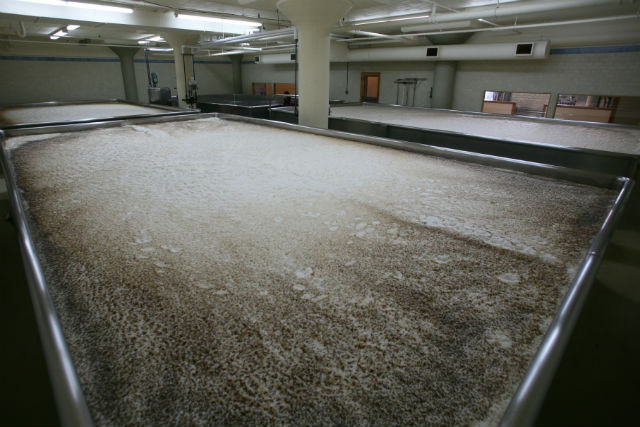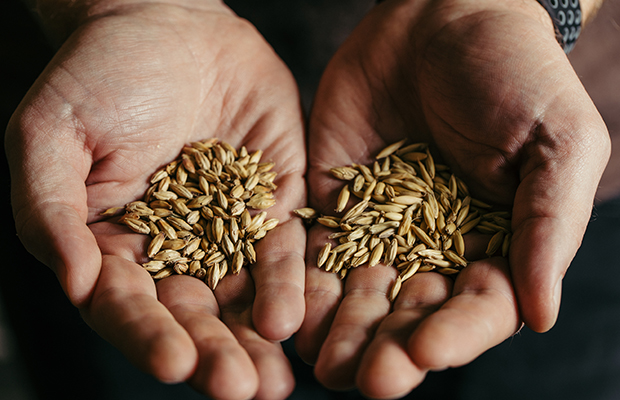
Cutting down on the cost of yeast can help a brewery save money. And, working on keeping a healthy yeast strain through the years not only helps with cost, but with consistency.
When you have developed your own yeast strain, it’s vital to keep it going. Both Saint Arnold and Thomas Creek have experimented with strains over the past few years while Anchor — a veteran of the craft beer community — has worked with its sames Lager and Ale yeast for hundreds and hundreds of generations.
Brewer Colin Klingemann at Saint Arnold said the Houston brewery developed a wild strain isolated from locally grown citrus fruit. They also have a proprietary Ale strain purchased from a brewery in England that is no longer in operation.
Consistency in the wild strain has yet to be seen, as they have only used it in one barrel-aged beer so far, he said.
“We measure the viability of all yeast strains via Nexcelom Cellometer and propidium iodide,” Klingemann said. “We consistently observed acceptable viability and attenuation across several propagation steps.”
Selection of the strain involved single colony purification on plate media, with approximately 10 mL overnight cultures; sensory selection after 50 mL forced fermentation, then propagation up to the desired pitching rate.
Owner Tom Davis at Thomas Creek said his brewery has two strains that are unique to just them, a strain from honeysuckle that was isolated by South Yeast and a house “funk” strain that a former brewer, Zach Newton, developed as a mixed culture.
“The purity of the honeysuckle is maintained by South Yeast and we only use it once a year for our Honeysuckle Saison,” Davis explained. “The mixed culture is maintained here in a liquid sugar substrate or harvested after emptying our seasoned oak barrels.
“As this ‘funk’ strain is wild it can change, but so far it has maintained a consistent profile.”
Thomas Creek does not clean its yeast, instead they restart their house strain every seventh generation.
“We do starters for the first batch and pull slurries for the rest of the generations,” Davis said. “For other strains, we will do a starter and grow it up as we need it, which dramatically reduces yeast cost, to me this is a very good ROI.”
The Anchor story — like it is for most veteran breweries — is a tad different.
“When it comes to yeast it is pretty unique and somewhat remarkable,” explained Brewmaster Scott Ungermann.
Owner Fritz Maytag bought the brewery in 1965 and he would get Lager strains from other breweries in San Francisco.
“It’s interesting because this is a common practice now that brewers kind of share strains and will lend enough to pitch in a pinch to one another,” Ungermann said. “Fritz would do that by getting yeast from the big guys because he wasn’t brewing all that frequently.
“He sometimes would get strains from Hamms or from various other places in town and eventually he got to the point where he was brewing frequently enough to have his own house strain for a Lager yeast. I don’t actually know the story of where we acquired our Ale yeast, but essentially since we started this brewery in 1979 we’ve had two house strains that live in two different rooms.”
With two fermentation rooms, the Ale yeast and Lager yeast never touch to minimize the risk of cross contamination with the brewery’s open fermenters.
“That Lager strain that we have had in-house here since 1979 has been collected and re-pitched successfully since,” Ungermann said. “The generations are up in the thousands.”
The open fermenters have a trough in the bottom for the yeast to settle into prior to being collected.
“We will collect that yeast and put it in a brink and then subsequently re-pitch,” Ungermann explained. “So essentially our brewing process keeps our yeast alive and gives us enough to re-pitch again and again and again.”
The brewery does an acid wash every two weeks to help drop the pH and clean it up, but Ungermann said that through the decades, the brewery has had ‘very robust, healthy yeast’ that has managed to live in the same environment for a long time.
“As long as we give it proper food and caring, it lives on without propagation,” he said. The story for Anchor’s Ale yeast is the same, which is used in the brewery’s Liberty Ale and Porter.
Ungermann said that Anchor does have library samples kept at a yeast lab should they ever have a catastrophic event, but they have been able to keep the yeast going in-house.
He noted that Anchor does viability tests but the fermentations over the years tell the story.
“If the beer ferments out in the right amount of time at the right temperature, then we know it’s going good,” he said. “Steam beer is a very unique process. It’s a Lager yeast fermenting at a warmer temperature and it’s a quick open fermentation — just three days — and the yeast will flocculate down into the trough and we collect it out of the trough and put it in the brink and then re-pitch it within a few days and and it lives on.
“But we perform lab analyses and have the ability to check viability. We have a microscope that we look at for morphology. Then we checked cell counts routinely just to make sure that everything is finishing up which it usually does.”
Ungermann did note that Anchor will reach out and get different yeast for different beers as well.
“If we make a Saison we will purchase and use for that, but it’ll be something that will just run a few generations and then move on because those beers are a special limited-release type of thing.”
The brewery is working with the new yeast strain right now called Sacch Trois — a non-flocculating Belgian yeast that Ungermann said gives off a very interesting fruity aromatics.
“We’re using it for a new IPA (San Franpsycho) that we’re about to release and we’re pretty excited about this for this particular beer,” he said “We don’t brew in open fermentation upstairs, so it’s a totally separate yeast system.
“We have brinks downstairs that are dedicated to our unitanks which are in a different place in the brewery and so that’s where we’re fermenting with the Sacch Trois.”
The beer is actually a mix fermentation: a blend of the Sacch Trois yeast that Anchor purchased and their house Ale yeast.
“We’ve found that blend finishes out properly and it gives a nice aromatic component,” Ungermann said.






Be the first to comment